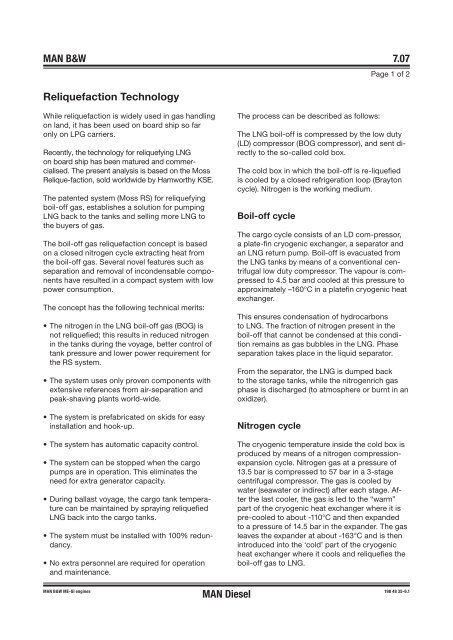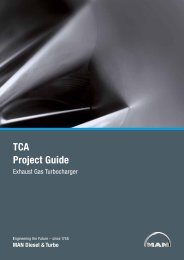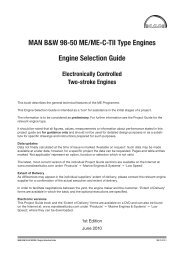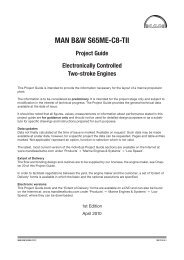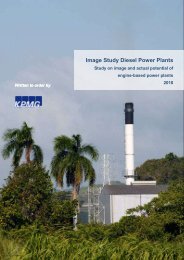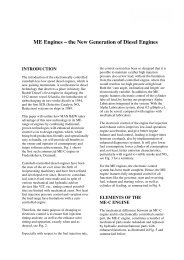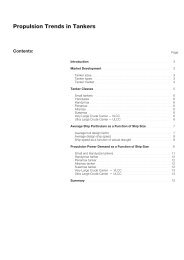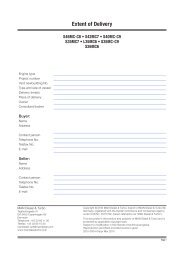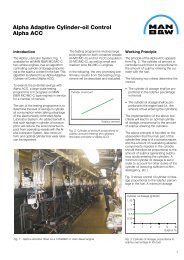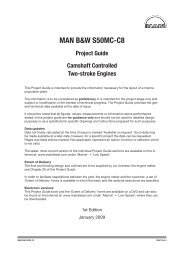This section is available on request - MAN Diesel & Turbo
This section is available on request - MAN Diesel & Turbo
This section is available on request - MAN Diesel & Turbo
You also want an ePaper? Increase the reach of your titles
YUMPU automatically turns print PDFs into web optimized ePapers that Google loves.
<strong>MAN</strong> B&W<br />
Reliquefacti<strong>on</strong> Technology<br />
While reliquefacti<strong>on</strong> <str<strong>on</strong>g>is</str<strong>on</strong>g> widely used in gas handling<br />
<strong>on</strong> land, it has been used <strong>on</strong> board ship so far<br />
<strong>on</strong>ly <strong>on</strong> LPG carriers.<br />
Recently, the technology for reliquefying LNG<br />
<strong>on</strong> board ship has been matured and commercial<str<strong>on</strong>g>is</str<strong>on</strong>g>ed.<br />
The present analys<str<strong>on</strong>g>is</str<strong>on</strong>g> <str<strong>on</strong>g>is</str<strong>on</strong>g> based <strong>on</strong> the Moss<br />
Relique�facti<strong>on</strong>, sold worldwide by Hamworthy KSE.<br />
The patented system (Moss RS) for reliquefying<br />
boil�off gas, establ<str<strong>on</strong>g>is</str<strong>on</strong>g>hes a soluti<strong>on</strong> for pumping<br />
LNG back to the tanks and selling more LNG to<br />
the buyers of gas.<br />
The boil�off gas reliquefacti<strong>on</strong> c<strong>on</strong>cept <str<strong>on</strong>g>is</str<strong>on</strong>g> based<br />
<strong>on</strong> a closed nitrogen cycle extracting heat from<br />
the boil�off gas. Several novel features such as<br />
separati<strong>on</strong> and removal of inc<strong>on</strong>densable comp<strong>on</strong>ents<br />
have resulted in a compact system with low<br />
power c<strong>on</strong>sumpti<strong>on</strong>.<br />
The c<strong>on</strong>cept has the following technical merits:<br />
• The nitrogen in the LNG boil�off gas (BOG) <str<strong>on</strong>g>is</str<strong>on</strong>g><br />
not reliquefied; th<str<strong>on</strong>g>is</str<strong>on</strong>g> results in reduced nitrogen<br />
in the tanks during the voyage, better c<strong>on</strong>trol of<br />
tank pressure and lower power requirement for<br />
the RS system.<br />
• The system uses <strong>on</strong>ly proven comp<strong>on</strong>ents with<br />
extensive references from air�separati<strong>on</strong> and<br />
peak�shaving plants world�wide.<br />
• The system <str<strong>on</strong>g>is</str<strong>on</strong>g> prefabricated <strong>on</strong> skids for easy<br />
installati<strong>on</strong> and hook�up.<br />
• The system has automatic capacity c<strong>on</strong>trol.<br />
• The system can be stopped when the cargo<br />
pumps are in operati<strong>on</strong>. <str<strong>on</strong>g>Th<str<strong>on</strong>g>is</str<strong>on</strong>g></str<strong>on</strong>g> eliminates the<br />
need for extra generator capacity.<br />
• During ballast voyage, the cargo tank temperature<br />
can be maintained by spraying reliquefied<br />
LNG back into the cargo tanks.<br />
• The system must be installed with 00% redundancy.<br />
• No extra pers<strong>on</strong>nel are required for operati<strong>on</strong><br />
and maintenance.<br />
<strong>MAN</strong> <strong>Diesel</strong><br />
The process can be described as follows:<br />
7.07<br />
Page of 2<br />
The LNG boil�off <str<strong>on</strong>g>is</str<strong>on</strong>g> compressed by the low duty<br />
(LD) compressor (BOG compressor), and sent directly<br />
to the so�called cold box.<br />
The cold box in which the boil�off <str<strong>on</strong>g>is</str<strong>on</strong>g> re�liquefied<br />
<str<strong>on</strong>g>is</str<strong>on</strong>g> cooled by a closed refrigerati<strong>on</strong> loop (Brayt<strong>on</strong><br />
cycle). Nitrogen <str<strong>on</strong>g>is</str<strong>on</strong>g> the working medium.<br />
Boil�off cycle<br />
The cargo cycle c<strong>on</strong>s<str<strong>on</strong>g>is</str<strong>on</strong>g>ts of an LD com�pressor,<br />
a plate�fin cryogenic exchanger, a separator and<br />
an LNG return pump. Boil�off <str<strong>on</strong>g>is</str<strong>on</strong>g> evacuated from<br />
the LNG tanks by means of a c<strong>on</strong>venti<strong>on</strong>al centrifugal<br />
low duty compressor. The vapour <str<strong>on</strong>g>is</str<strong>on</strong>g> compressed<br />
to 4.5 bar and cooled at th<str<strong>on</strong>g>is</str<strong>on</strong>g> pressure to<br />
approximately – 60°C in a platefin cryogenic heat<br />
exchanger.<br />
<str<strong>on</strong>g>Th<str<strong>on</strong>g>is</str<strong>on</strong>g></str<strong>on</strong>g> ensures c<strong>on</strong>densati<strong>on</strong> of hydrocarb<strong>on</strong>s<br />
to LNG. The fracti<strong>on</strong> of nitrogen present in the<br />
boil�off that cannot be c<strong>on</strong>densed at th<str<strong>on</strong>g>is</str<strong>on</strong>g> c<strong>on</strong>diti<strong>on</strong><br />
remains as gas bubbles in the LNG. Phase<br />
separati<strong>on</strong> takes place in the liquid separator.<br />
From the separator, the LNG <str<strong>on</strong>g>is</str<strong>on</strong>g> dumped back<br />
to the storage tanks, while the nitrogenrich gas<br />
phase <str<strong>on</strong>g>is</str<strong>on</strong>g> d<str<strong>on</strong>g>is</str<strong>on</strong>g>charged (to atmosphere or burnt in an<br />
oxidizer).<br />
Nitrogen cycle<br />
The cryogenic temperature inside the cold box <str<strong>on</strong>g>is</str<strong>on</strong>g><br />
produced by means of a nitrogen compressi<strong>on</strong>�<br />
expansi<strong>on</strong> cycle. Nitrogen gas at a pressure of<br />
3.5 bar <str<strong>on</strong>g>is</str<strong>on</strong>g> compressed to 57 bar in a 3�stage<br />
centrifugal compressor. The gas <str<strong>on</strong>g>is</str<strong>on</strong>g> cooled by<br />
water (seawater or indirect) after each stage. After<br />
the last cooler, the gas <str<strong>on</strong>g>is</str<strong>on</strong>g> led to the “warm”<br />
part of the cryogenic heat exchanger where it <str<strong>on</strong>g>is</str<strong>on</strong>g><br />
pre�cooled to about � 0°C and then expanded<br />
to a pressure of 4.5 bar in the expander. The gas<br />
leaves the expander at about � 63°C and <str<strong>on</strong>g>is</str<strong>on</strong>g> then<br />
introduced into the ‘cold’ part of the cryogenic<br />
heat exchanger where it cools and reliquefies the<br />
boil�off gas to LNG.<br />
<strong>MAN</strong> B&W ME�GI engines 198 48 35�6.1


